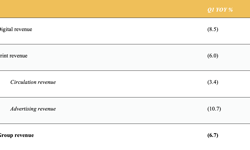"Our job is to be a conduit between publishers and retailers, to optimise availability with the lowest number of copies available," states Mark Cashmore, the chief executive of Smiths News, the UK’s largest wholesaler. Smiths News delivers an astonishing 59 million publications to 22,000 customers every week and, in the year up to August 2007, made a pre-tax profit of £31 million. Two years have now elapsed since the Board of WHSmith first announced the demerger of its retail and news distribution businesses. In that time, Cashmore has helped to shore up Smiths News’ 39% market share, but he is far from resting on his laurels and is forever looking to improve the company’s performance.
Tackling waste
Cashmore constantly scrutinises the wholesaler’s operations, making them run more efficiently so that publishers can print fewer copies of their titles and retailers can make the most of the newspapers and magazines with which they’re supplied. He is passionate about reducing waste in the publishing industry and is determined to implement systems which can help Smiths News do just that. Top of the list comes sales based replenishment (SBR) – an initiative also offered by other wholesalers, including the UK’s second largest wholesaler, Menzies Distribution. SBR works with electronic point of sale (EPOS) data to help meet demand with greater accuracy. The concept is based on using sales data to avoid under or over-supplying.
"We are acknowledged to have the industry-leading offer in that area," claims Cashmore proudly, "and have invested huge amounts of money in our computer system which underpins our twin goals of providing service and driving efficiency."
Large multiple retail outlets, such as supermarket chains, represent over 50% of Smiths News’ total sales, and data returned from those outlets that have the SBR system has generated persuasive evidence for it to be more widespread. Unsolds have been reduced by 7% and availability has increased by 15%. "This allows you to print less but sell the same," surmises Cashmore, "so it’s good news for everyone."
Trust trading
One other way in which he intends to maximise efficiency is by encouraging big retailers to move towards a trust trading environment. In practice, this would mean that retailers would save time and energy by taking it on trust that a certain number of copies have been dispatched rather than laboriously having to check manually. "Our accuracy is 99.9%," claims Cashmore. "If one copy happens to be missing, the time and energy taken to check clearly outweighs the cost of that single copy. We find we are e-trading at a head office level, but need to translate that to trust trading at a store level. The investments that we’ve made in our systems and the transparency which that supplies should enable retailers to see that trust trading is an effective way to work with us."
Indies
Independent retailers, however, present a different set of challenges. Of the 14,000 with whom Smiths News works in the UK, just 100 regularly supply the wholesaler with reliable EPOS data. Such data is vital to reducing waste in the supply chain. So Smiths News is exploring ways in which it can encourage independents to implement EPOS systems, for instance, interest-free loans for purchasing the equipment. Yet Cashmore understands that the issue here may be cultural rather than financial, with independent retailers simply accustomed to a particular way of working which doesn’t involve EPOS. Indeed, many independent retailers actually have EPOS tills, he says, but they’re not always plugged in so they can’t transmit data on a daily basis. "Unless we can persuade them to do that, we can’t extend the services that we supply to the multiples to the independent retailers," he says.
This is crucial going forward, because 60% of newspaper sales take place in independent retailers. Cashmore accounts for this figure by saying that home news delivery accounts for a large chunk of this impressive percentage – a service which large multiples don’t offer. "We want to be smarter about what we allocate. For instance, if 20 copies of the Telegraph go to an independent retailer, we want to know how many of those are delivered to homes as opposed to going onto the counter. If eight are casual sales copies, the allocated product could be more streamlined. This kind of data allows us to drive a more sophisticated model around home news delivery."
Smiths News is also keen to advise independent retailers on how to maximise their space. "It’s true to say that in the past we have sent too many titles to independents," he admits. "We want to avoid that cluttered look by improving how they use their space to stock the titles that we send."
The future of print
And there will always be a place for print, believes Cashmore. Even though he is all-too aware of how digital platforms are becoming more prevalent, he takes heart in News International’s recent £650 million investment in what’s claimed to be the biggest print plant in the world in Broxbourne, Hertfordshire - as proof, if it were needed, that print is not dying a death. "Rupert [Murdoch, News International chairman] is not silly and that’s a pretty strong statement about the longevity of newspapers." As for magazines, he believes that publishers have become adept at finding ways to excite readers about their brands. "There’s a history of reinvention with magazines and while I don’t think we’ll see the degree of launch activity that we’ve seen over the last ten years, I do think there are other niches that have yet to be discovered. Remember, ten years ago, we didn’t have men’s weekly titles, or real-life titles, and Hello! and OK! were the only celebrity magazines."
Cashmore also admires how magazines and newspapers are rejuvenating their proposition through attention-grabbing promotions. "The Mail on Sunday which cover-mounted the Prince CD was the second highest selling of the paper ever and proves that newspapers can innovate and that we shouldn’t be all doom and gloom about their future."
That said, he is cautious about being overly-optimistic, particularly when an economic slowdown is likely to prompt a shake-out. "While the quality brands will survive and prosper, some of the third or fourth biggest brands are going to have a tougher time. Within the weeklies market, for instance, there was an explosion of launches, but now a clear-out wouldn’t be such a bad thing."
Pricing
He is a staunch believer in the value of magazines and newspapers. "They are good value-for-money low-ticket items in a world where a coffee from Starbucks is £2.50. Inevitably, publishers get nervous about price rises, but when the advertising market is tough, they are more reliant on circulation and there is still a lot of opportunity in terms of price: OK! recently went from £2 to £2.50, but it’s continued to prosper. What’s more, six million people buy a TV listings title every week, despite being able to get that information free of charge from digital platforms."
Cashmore also cites children’s magazines – particularly anything to do with Dr Who – as "remarkably successful" along with football magazines, although he’s disappointed in the quality of recent part-works series. As for cover-mounts, he says that they pander to consumer promiscuity, but concedes that "they have been around for so long now that they’ve almost become an expected part of the package."
Overall, he admires how publishers are investing in and around their brands through launches and promotions. As someone whose livelihood relies on the printed product, he makes no secret of the fact that he’d love to see more investment in print rather than digital media, but describes himself as "pragmatic enough to realise that publishers have to look at how to best serve their audiences, and that might involve a number of different channels." The upside of that, however, is that branded digital platforms can often reinforce the power of print. "Publishers are looking at how they supply their content to the consumer, and that means that there will often be more than one channel. That isn’t necessarily a bad thing. If you can have a great website or TV station, you can often persuade people to engage with the brand and drive them back to newsstands."
In terms of how publishers could work more efficiently themselves, he suggests that they could be more mindful in terms of duplicating systems which wholesalers have already implemented. "I would rather they put money into their product rather than investing in systems which may already exist," he says.
Don’t mention the ... OFT
Asked about his feelings towards the Office of Fair Trading decision which could end up reconfiguring the distribution of newspapers and magazines in the UK, he groans and says: "It’s the sixth year of investigation which is just crazy. We – like many other people – have given up trying to pre-guess the outcome. Instead, we’re focusing on our own strategy which is to be the preferred wholesaler for our customers."
His faith in the current system is apparent. Smiths News plays a leading role in ensuring that more than 14 million newspapers are delivered to 54,000 retailers in a three-four hour slot every night – a process described by the Freight Transport Association as ‘the nightly miracle’. "We believe that the existing supply chain offers the most efficient route to market for magazines and newspapers, and we think that it will continue to evolve."
Whatever the OFT eventually decides, Cashmore remains firmly focused on his own organisation and is determined to maintain its market-leading position: "We need to ensure that our business is fit for tomorrow’s market, whatever that might look like."
FEATURE
Mark Cashmore - interview
The wholesaler is the link man in the news supply chain – taking copies from the publisher and ensuring their timely distribution to retail. Sitting in the middle, they inevitably have a more balanced view than those at either end of the chain. Lucy Aitken talks to Smiths News’ chief executive, Mark Cashmore, about the challenges facing the industry.










